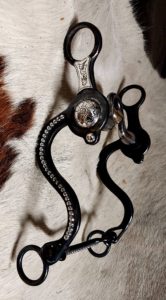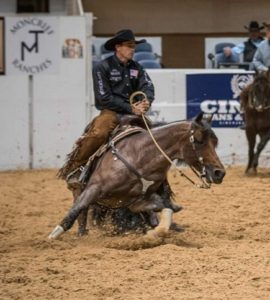The pinnacle of cow horses is the bridle horse.
“The bridle horse is the finished product,” Randy Paul said.
 Paul is an NRCHA $522,165 earner and has won $1 million in the NRHA. He is also a bit maker. He doesn’t have a website but his bits are a favorite among the cow horse community.
Paul is an NRCHA $522,165 earner and has won $1 million in the NRHA. He is also a bit maker. He doesn’t have a website but his bits are a favorite among the cow horse community.
“You’re training him when he is three to be a good horse when he’s 10,” Paul said. That foundation begins in the snaffle bit and ends with a bridle.
To prepare the horse for the bridle stage the horse will usually compete in the two-rein which means a thinner hackamore is added under the bridle to help the horse transition to the bridle.
At the start of a horse’s career, each trainer will ride in various bits with a shank to establish the feel in their mouth.
For Paul, he begins using a shank snaffle with leather curb to let them get used to reacting off the curb.
“I usually just go to a solid mouthpiece. I don’t typically ride in a correction much,” Paul said.
A correction is a bit with shanks and a port that is jointed on both sides of the port. If the horse is wiggly, Paul will ride them in a solid bit and if they are stiffer and need help laterally, he will ride them in a loose shank bit.
$1.1 million earner Phillip Ralls has a slightly different approach.
“I don’t train in the two-rein a lot. I spend more time teaching my horses how to be in the bridle as early as their four year old year. Starting out in a grazer bit [and then move] on up,” Ralls said.
He then teaches them how to neck rein. As a four and five year old they are still sometimes showing in a snaffle bit but they have the basic understanding of neck reining.
“By the time I transition to the two-rein that horse has already been ridden in some small short shank bridles for a little while. They’ve been loped in and taught how to steer and guide. It’s a big transition to the two-rein year,” Ralls said.
“That first year in the two-rein gives us that year for those horses to get some exposure and learn how to be shown one-handed and give us a good platform into the regular bridle.”
Paul said, “[The two-rein hackamores] are smaller in diameter so they fit under the bridle. A regular hackamore would be too bulky and wouldn’t allow the bridle to function correctly. [The two-rein hackamore] is almost as small as a typical cavesson (noseband)”.
Two-Rein and Bridle >>>
“For me the purpose of the two-rein …. They will allow you to put your fingers between the reins to help you get their nose…. if a horse is a little green in the bridle they can shorten the second rein and work off of the nose pressure of that hackamore to help those horses maintain their form and quality,” Ralls said.
“It’s a good transition to be able to help them a little bit while you’re showing, whereas when you’re in the bridle you can’t put any fingers between the reins. You have to keep your hand closed around the reins when you’re showing in the bridle.”
In the tack-room, Ralls will have other types of bits with a shank as transition bits, similar to cutting-style bits.
“I start all my bridle horses, before they’re bridle horses, steering in a short shank Kerry Kelley that has a low port that I like a lot. I use it almost everyday. I have a short shank Buster Welch style bridle that I believe Daryl Davis made. Those are my two bits I like to start my horses’ neck reining,” Ralls said.
“I’m really working on the neck reining and steering aspect of it before I worry about how much collection I want,” Ralls said.
“In my opinion the toughest thing to teach a bridle horse to do is to bring his nose first when you’re one handed. So I start very early in their career where there’s no show around the corner and no pressure… It takes a long time to really get them right. That’s something that takes the longest,” Ralls said.
As a training exercise, Paul has some bits with no reins on the horse. He gets the horse to just hold that bit in their mouth.
“It just gets those horses where they pick that bit up and hold it. They don’t just have the bit in their mouth when you’re riding them. They can learn to just sit there and hold the bit. I think you get less gapping and less resistance. Some will chew on it and play with it. Eventually they just hold it and when you’re riding them they’ll hold it in the same manner which is what we’re after…”
“Horses are creatures of habit. Which is why we can train them. And if you can create good habits, anything like that is a good thing.”
“It really exposes and shows you where your horse is with you and where he’s not with you when you start riding him one handed. That’s why before I have to call on them and use them one-handed, I spend a lot of slow time riding around guiding, steering and getting that foundation one-handed so when I start riding them in the bridle it’s a little easier,” Ralls said.
When turning down the fence at speed you have to be able to handle them, Ralls said.
“I want that horse to come with his nose first, accept that outside rein and neck rein and come with his nose first. It takes a lot of reps to get that foundation in there,” Ralls said. “When you pick your hand up and point in a direction, they can’t be wondering which way you’re going to be going. You need to be able to steer at speed and try to maintain the form and quality you’re looking for. That’s the hard part when you’re going fast,” Ralls said.
Ralls said you could start showing a horse in the bridle class at any age but you can’t go backwards. Typically six and older are shown in the bridle.
A show bridle must have a cricket or roller in the mouthpiece per the NRCHA rule book, however the options are vast. (For specific bit rules, please see the NRCHA rulebook.)
Ralls has 15 different bridles in the tack room while Paul has about 30 different bridles.
Having a range of bits gives the trainer options, not just for what they are trying to achieve, but importantly to find each horse’s preference.
Renowned horseman Todd Bergen said, every horse likes something different.
As Bergen gets to the more advanced stages of bridles, he will try many bits in the horse’s mouth because they may surprise you with what they like.
“I’m always experimenting and trying to find that bridle I like on that horse… It’s the individual, they all like something a little bit different,” Bergen said.
The difference in perspective, from viewing a bit as a tool to make a horse do something to viewing it as something a horse is choosing to help itself do something, can be a profound one.
“Sometimes you’re trying to let the bridle do the training for you. And I think you really need to train your horse but you need to use [the bits] to help aid you in the training and let them do their job. Instead of trying to be rough and quick because you know you had to put a bigger bit in,” Bergen said.
Bergen recommends riding your horse the same no matter what bit you have in their mouth. He believes you will get them trained faster.
